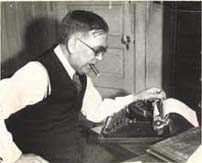“A masterpiece is just a successful experiment. You never hear of the unsuccessful ones.”
Gil Evans (quoted in Gene Lees, Arranging the Score)
TT: The graveyard of the new
“Did you know they’ve started making guitars that tune themselves?” asked my trainer, who is a serious amateur guitarist.
“That’s so cool,” I replied. (I talk that way at the gym.)
“I dunno,” he said. “Seems kind of redundant to me.”
“I know what you mean,” I said, “but it doesn’t matter–it’s still cool.” And it is, very much so. Like most men, I am a medium-bore neophile who regards labor-saving technology as an absolute boon and expensive gimmickry as self-justifying, and a guitar that tunes itself hits the bull’s-eye on both counts.
But I also have a long memory, and my trainer’s question immediately put me in mind of the recent announcement that Polaroid will stop manufacturing self-developing film later this year. The once-miraculous “instant cameras” that first went on the market in 1948 were rendered irrelevant by the introduction of digital photography, and in a matter of months they will all be museum pieces, henceforth destined not to take snapshots but to gather dust in never-opened closets.
My father, who was a devoted gadget buff, owned two Polaroid cameras and bought me a third, the budget-priced Swinger, whose cheery TV jingle rattles around pointlessly in my head to this day:
It was one of the many shiny pieces of up-to-the-minute stuff that briefly brightened my childhood, then was relegated to the capacious basement of my home in Smalltown, U.S.A., as soon as something newer and better came along. That’s what happened to my first portable phonograph, my first reel-to-reel tape recorder, my first cassette deck…the list goes on and on. Some got carted off to the garbage dump, but most continue to molder in that same basement, unused and unusable, totally forgotten save on the rare occasions when a passing remark brings one of them to mind.
Three years ago I posted a list of “things I no longer use, do, or see.” Thinking about my old Swinger put a different set of memories in my head, and I started drawing up a list of inventions I first encountered when young that are now taken for granted. I’m not talking about cable TV, VCRs, Walkmen, answering machines, or word processors–those came later–but the once-astonishing inventions of my childhood that have since woven themselves into the fabric of American life as securely as a dead metaphor:
• Direct long-distance dialing. Most long-distance calls were still placed through operators well into the Sixties. You could call person-to-person or collect, and neither way was cheap, so my parents figured out a way to finesse the system. As soon as we returned to Smalltown from a midwinter visit to my grandmother’s house, my mother would immediately place a person-to-person call to my grandmother–using a code name instead of her real name. Grandma would then politely decline to accept the call and hang up, knowing that we’d gotten home safely. (How many other small-town folk used the same trick?) Then Direct Distance Dialing arrived in our neck of the woods, at which time the Smalltown telephone exchange, which had previously been known as GRanite-1, became the infinitely less exotic 471, and the romantic days of person-to-person calls and Double-Secret Code Names came to an end.
• Fast food. In southeast Missouri it started with McDonald’s, as it did in most parts of America, but for many years Smalltownians had to go to Cape Girardeau, a half-hour north of us, to buy their Big Macs. The first modern fast-food burger chain to lay down a marker in Smalltown was the now-defunct Burger Chef, which advertised its wares with another idiot jingle that I can still sing: French-fried potatoes/Crisp and fresh/And the greatest fifteen-cent/Hamburger yet. It was, too, as far as I was concerned.
• Electric car windows. I’ll never forget the year that my father bought a car with motorized windows. I must have spent a good half-hour sitting in the driver’s seat, opening and closing them over and over again. They seemed to me to be the very quintessence of industrial magic.
• Color television. We bought our first color TV, a Curtis Mathes set with a round picture tube, in 1964 or 1965. The first shows I remember seeing in color were Batman and (naturally) Walt Disney’s Wonderful World of Color, though even before that I can remember marveling at the animated peacock that introduced all shows broadcast in Living Color on NBC:
• Automobile tape decks. One doesn’t run into them very often these days–the CD has replaced the cassette, and is itself well on the way to being replaced by the iPod and its progeny–but the idea of being able to listen to music of your own choosing in a car remains very much with us. When I was young, though, it was a privilege, not an entitlement. Back then we listened to whatever was playing on the radio, and in Smalltown, U.S.A., we had a grand total of two stations from which to choose.
Then, in 1964, the eight-track tape cartridge was unleashed on an astonished world, and within a year or two my father had bought a new car that contained a factory-installed tape player. He bought the tapes, too, which meant that we mostly listened to Stan Kenton and Frank Sinatra (neither of whom I had yet learned to appreciate) on our Sunday drives to nowhere in particular. But the eight-track player was a great invention all the same, and nowadays I can’t imagine life without its descendants, which have seen me through many a traffic jam. I once listened to all five of Beethoven’s late string quartets while stuck in Labor Day traffic on the Pennsylvania Turnpike, with Benjamin Britten’s The Turn of the Screw thrown in as an encore.
• Digital clocks. Do you remember learning how to tell time? I do, and I wonder whether children raised in the digital age find the faces of old-fashioned clocks as mysterious and inscrutable as I did when I was a boy.
• Photocopiers. They came to Smalltown, U.S.A., some time in the early Seventies. Before that you used carbon paper, or typed your document on a stencil and ran it through a quaint old machine called a mimeograph that produced moist, strange-smelling copies printed in purple ink.
• Personal calculators. I belong to the last generation of American high-school students that learned how to use a slide rule. In my senior year, the students in my physics class were permitted to check the computation on their exams by using a desk-model calculator that was kept on the teacher’s desk. My father gave me a solar-powered handheld calculator as a going-away-to-college present, back in the days when such devices still cost a fair amount of money.
 “The only modern inventions that have been of any real use to me are the typewriter and the Pullman car,” H.L. Mencken told an interviewer in 1946, ten years before his death. Both, needless to say, are now obsolete. Unlike the self-consciously cranky Mencken, I’ve always embraced technological change, and I couldn’t begin to list the inventions of the past half-century that have improved my life.
“The only modern inventions that have been of any real use to me are the typewriter and the Pullman car,” H.L. Mencken told an interviewer in 1946, ten years before his death. Both, needless to say, are now obsolete. Unlike the self-consciously cranky Mencken, I’ve always embraced technological change, and I couldn’t begin to list the inventions of the past half-century that have improved my life.
Yet I can’t help but ask: how many of the aforementioned devices will have been carted off to the graveyard of superannuated technologies a half-century after I, too, am dead and buried? They were and are wonderful–but so was my little Polaroid Swinger, which cost $19.95, just like the jingle said, and gave me at least a hundred thousand dollars worth of pleasure. Sic transit!
TT: Coming to pass
Paul Moravec and I will be spending the next few days sitting in a midtown rehearsal studio, helping a group of professional singers learn the first six scenes of The Letter, our Somerset Maugham opera-in-progress, in preparation for a pair of private workshop performances that will be presented later this week by Santa Fe Opera.
Paul and I saw the first run-through of The Letter on Saturday morning. I can’t begin to tell you how exciting an experience it was. No details just yet, but suffice it to say that things are going very, very well.
I’m going to be tied up tight all week, so forgive me in advance for my absence from the blog. I’ll fill you in when I return.
TT: Almanac
The auld aik’s doun:
The auld aik’s doun:
Twa hunner year it stüde, or mair,
But noo it’s doun, doun.
The auld aik’s doun:
The auld aik’s doun:
We were sae shair it wud aye be there,
But noo it’s doun, doun.
William Soutar, “The Auld Aik” (The Old Oak)
TT: Five myths, direct from Pyongyang
 I stirred up quite a storm with my two columns in The Wall Street Journal about the New York Philharmonic’s visit to North Korea. Now the trip has come and gone, and a fair amount of nonsense is being talked about it, both by Lorin Maazel, the orchestra’s music director, and by the arts community in general. So my “Sightings” column in today’s Journal returns once more to the subject. Here’s a sample.
I stirred up quite a storm with my two columns in The Wall Street Journal about the New York Philharmonic’s visit to North Korea. Now the trip has come and gone, and a fair amount of nonsense is being talked about it, both by Lorin Maazel, the orchestra’s music director, and by the arts community in general. So my “Sightings” column in today’s Journal returns once more to the subject. Here’s a sample.
* * *
Now that the New York Philharmonic has paid its long-awaited visit to North Korea, the floodtide of justificatory gush has begun. Lorin Maazel, the orchestra’s music director, intoned that “in the world of music, all men and women are brothers and sisters.” A South Korean newspaper described the trip as “an overture to peace between the North and the United States.” The Los Angeles Times called it “a publicity coup for an institution…much in need of a lift.” And Eric Clapton says he’s been invited to play in Pyongyang.
Eric Clapton?
Things are starting to get a little silly here. So before any more 62-year-old rock stars decide to hop the next plane to Pyongyang, allow me to point out five mistaken ideas about the Philharmonic’s concert….
* * *
To read the whole thing, go here.
TT: “You kinda act too white”
In today’s Wall Street Journal drama column I review two New York musicals, Passing Strange on Broadway and Adding Machine off Broadway, plus the last of the six shows I recently saw in California, Wishful Drinking. Here’s a sample.
* * *
 Stew, a 46-year-old singer-songwriter from California with no stage experience, has brought a semi-autobiographical show to Broadway that bears no resemblance to your standard-issue faux-pop musical. In fact, “Passing Strange,” which comes to Broadway from the Berkeley Repertory Theatre by way of New York’s Public Theater, is less like a book show than a rock concert with interpolated skits, and it’s so rough-hewn in spots as to border on the naïve. It’s also the freshest musical in town, in part because Stew (whose real-life name is Mark Stewart) and his songwriting collaborator, Heidi Rodewald, are either ignorant of the conventions of musical comedy or don’t care about them. Most likely they’re more knowing than they let on, but it doesn’t matter: “Passing Strange” is the most original Broadway musical since “The Light in the Piazza,” and my guess is that it is headed for a long, profitable and influential run.
Stew, a 46-year-old singer-songwriter from California with no stage experience, has brought a semi-autobiographical show to Broadway that bears no resemblance to your standard-issue faux-pop musical. In fact, “Passing Strange,” which comes to Broadway from the Berkeley Repertory Theatre by way of New York’s Public Theater, is less like a book show than a rock concert with interpolated skits, and it’s so rough-hewn in spots as to border on the naïve. It’s also the freshest musical in town, in part because Stew (whose real-life name is Mark Stewart) and his songwriting collaborator, Heidi Rodewald, are either ignorant of the conventions of musical comedy or don’t care about them. Most likely they’re more knowing than they let on, but it doesn’t matter: “Passing Strange” is the most original Broadway musical since “The Light in the Piazza,” and my guess is that it is headed for a long, profitable and influential run.
The best thing about “Passing Strange” is the book, which shows us a side of black life in America that rarely gets talked about, much less sung about. The show’s nameless hero (well played by Daniel Breaker) is a PBS-watching, guitar-strumming Los Angeles kid who knows nothing of street life and prefers punk rock to soul. Longing to escape the philistinism of his suburban life, he hops a plane to Europe, flings himself into the bohemian scene, and becomes a performance artist who plays the race card in order to wow his leftist friends (“Yeah, Mr. May 68: do you know what it’s like to be the object of oppression living under police occupation in the ghetto?”). Not only does Stew skewer his youthful artiness with a self-mockery that makes the just-be-yourself-man earnestness of the last scene easier to stomach, but he is forthright about the pressure that the black community brings to bear on middle-class blacks who refuse to conform to its own racial clichés…
The only thing that “Adding Machine” has in common with “Passing Strange” is that it isn’t a conventional musical. This Chicago-to-Off-Broadway transfer, adapted by Jason Loewith and Joshua Schmidt from the 1923 play, takes Elmer Rice’s once-iconic, now-forgotten story of a beaten-down bookkeeper who hates his wife and murders his boss and turns it into a one-act techno-minimalist opera of near-arrogant sophistication. Would that Mr. Schmidt’s score were as memorable as it is slick, but the small-scale production, directed with awesome self-assurance by David Cromer, is so effective that you almost forget how forgettable the music is….
Addiction, mental illness, movie-star parents, bad marriages, really bad hair…Carrie Fisher, right? You got it: Princess Leia has recycled her nightmarish life yet again, this time putting it onstage in the form of an exceedingly clever one-woman show called “Wishful Drinking.” Berkeley Rep, which brought “Passing Strange” into the world a year and a half ago, is now giving the hapless daughter of Debbie Reynolds and Eddie Fisher an opportunity to be drop-dead funny about a string of personal crises so horrific that the only alternative to laughing at them is slashing your wrists in sympathy…
* * *
Read the whole thing here.
TT: Almanac
“In America, the race goes to the loud, the solemn, the hustler. If you think you’re a great writer, you must say that you are.”
Gore Vidal, interview, Writers at Work, Fifth Series
CAAF: Here’s the church, and here’s the steeple

This is White Rock Hall, née White Rock Church, built in 1909 and located in Madison County, about an hour north of Asheville. It belongs to our friends Keith Flynn and Denise Petry. Keith is a poet, author, musician, and the editor of the Asheville Poetry Review, and the church is the first piece of a small arts retreat and conference center he and Denise are putting together. When the campus is complete, there’ll be class spaces, a recording studio, and cottages for overnight stays.
On Saturday, Lowell and I were invited to watch the church get moved from its original spot, at a crossroads, to its new home on a nearby hillside, where it will preside over some beautiful rolling acreage. The morning was cold and gray with a steady drizzle, and the operation got halted a couple times due to wet conditions and an aggressive tree incursion. A couple officers from the Madison County Sheriff’s Department were on hand to control (the nonexistent) traffic and, Keith said, to shoot the moving crew’s foreman “if he drops my church.”
The church had been shut up for a number of years before it went up for sale (it has no power or electricity, and there’s a bigger brick church down the street); a neighbor who was watching the move, a Mr. Hensley in a green John Deere cap, told me he’d last been inside for a funeral in 1966. But the building is still lovely in its bones, with what Denise calls its witch’s hat on top and a bell that clanged once — loudly — as the church got hoisted from its original spot.
Photo: “White Rock Hall Arrives” by Lowell Allen. If you squint you can see a lone figure standing on the hillside behind the church holding a beige umbrella. That’s me! Catching a cold! More photos here.
